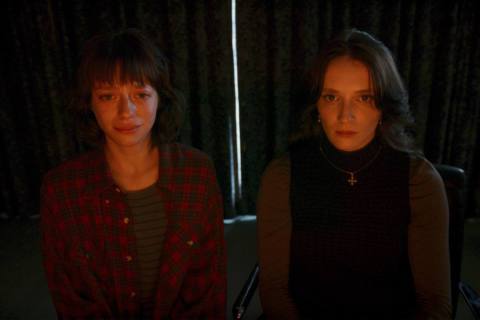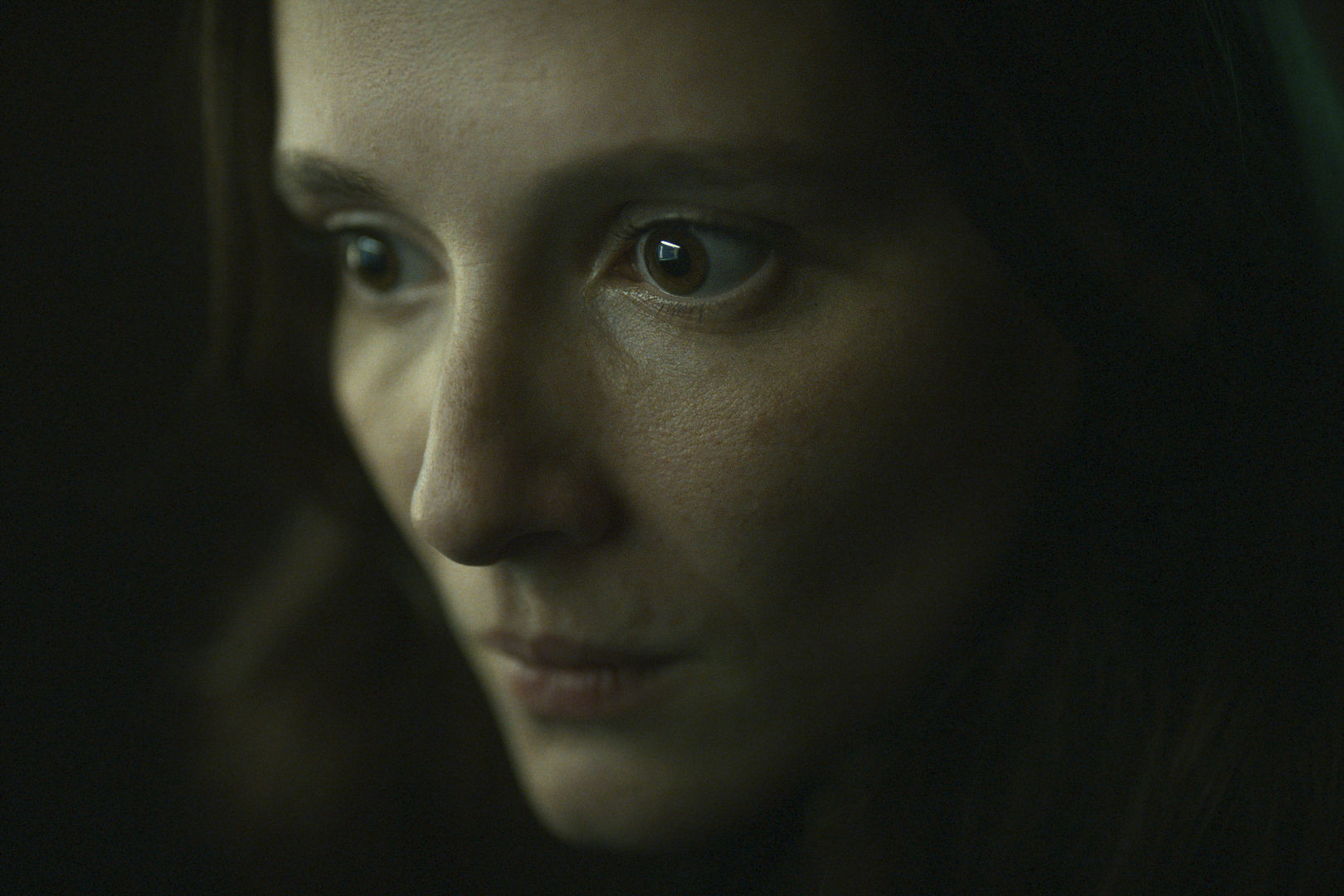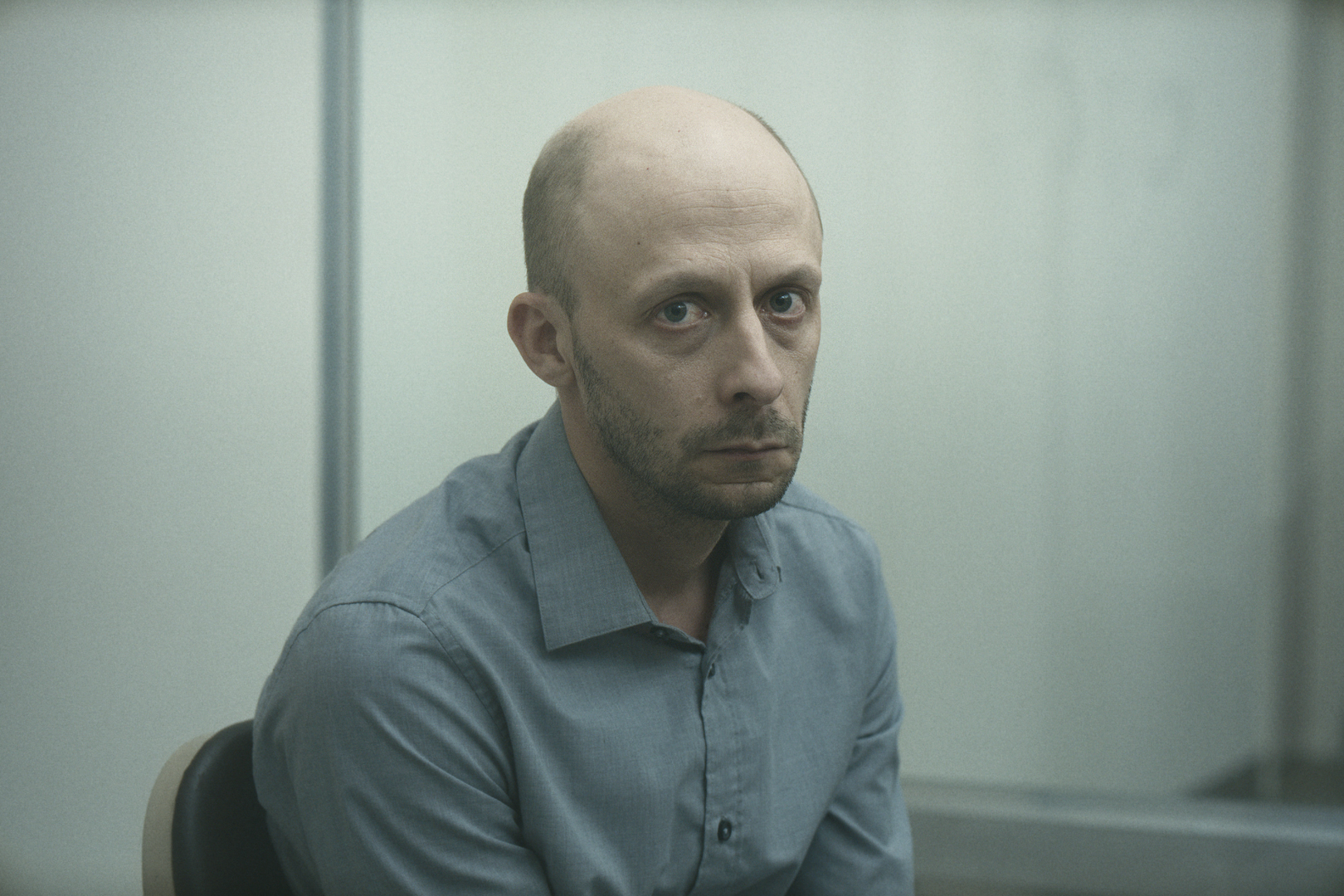
Canadian filmmaker Pascal Plante was already dwelling on the eldritch terrors that lurked below the surface of the dark web before the COVID-19 pandemic sent him into lockdown. But by 2021, his self-inflicted misery, combined with sitting at home for long stretches of time, resulted in the screenplay for Red Rooms.
A brilliant examination of parasocial voyeurism in our current true-crime content vortex, Red Rooms follows Kelly-Anne, a model who can’t look away from a high-profile serial killer case. She attends the trial, glued to every update about the accused from the back row, as lawyers describe his livestreamed murders in gruesome detail. She returns home to Google every imaginable lead, and comes up for air to gamble crypto on online Texas Hold ’em. Occasionally, she books a photo shoot. Where her life — and Plante’s film — goes is unexpected and creepy as hell.
Red Rooms isn’t an obvious selection for spooky-season viewing, but Plante is in total control as he veers from austere thriller to the kind of horror that would tickle Brian De Palma fans. It shook me to my core. With the film out in theaters and rentable on digital platforms, Polygon spoke to Plante about how he went this dark — and entertaining — without going over the line.
This interview has been edited and condensed for clarity.
Polygon: You’ve been thinking about and working on this one for many years. How does it look to you now with some distance?
Pascal Plante: I’m still happy that it has a conversation with whatever the current times are, because time moves fast, especially in a film that dabbles with technology. I actually had to flirt with sci-fi when I was writing. Let’s say her AI, for instance — it’s weird to say now, but ChatGPT was not around [in 2021]. And so for a technogeek film to be current, you need to think about how people use technology, what will make it relatable, even though maybe some of the things will get dated sooner or later. Everything about this movie technology-wise is going to be dated. But it gets you thinking a lot more about the tools, and human nature, and how humans interact with those tools. And that doesn’t change, really.
The movie was born out of the cult-like interest that can convene around murderers. How did you extrapolate that into a thriller that could work as a movie?
I have a documentarian tendency where I know we’re making fiction and we’re bending truth, and that’s fine. But I value a lot of films that are able to depict niche subcultures in a relatable way, in a way where I’m not just empirically exploiting and stealing from the folklore of a scene in order to make something completely fictional. I would love, in an ideal world, that the people that are knowledgeable about what I’m trying to talk about and distill in an artistic vision, that they can be the one who endorse the film first, in a way.
You want serial-killer obsessives to say: “You see me.”

I know you’re making a joke, but we had one encounter after a Q&A — a woman came up to me and the producer and said that she’s herself a fan of killers, and she devotes so many hours a day to them, and all that. I’m actually glad this happened, because it shows that I’m not overly judgmental about the characters. I’m trying to study the phenomenon, and the phenomenon is rooted in society. These behaviors are allowed and enabled by something macroscopic. That is what I’m trying to get across.
I’m not trying to say that this is a crazy woman and she’s evil and all that. It’s way more than that. So just the fact that that person was comfortable enough to come and talk to us meant a lot. It just meant that I try to make valuable art that can engage in topical and harsh conversations. But no, I was more talking about people on the dark web who hang out on the internet. I wanted people permanently online to watch the film and be like, “Oh, [she’s] one of us.”
It sounds like you did a great deal of research around the topics of serial killers and the dark web experience, but how did that cohere into the film? When and where does imagination fit in?
It has to become a movie at one point, because research can only get you so far. I’m not doing a PhD. I’m not devoting my life to it. I’m devoting, like, a three-year cycle of my life. That was my obsession in that time frame. And at one point, yeah, I had to let the research go and start writing. The imagination has to take over. And it was much more of a safe space than the research part, because the research was rooted in something so grim and so depressing.
Doing a genre film for a filmmaker in 2024 is actually amazing, because genre-film fans are very audacious. They want singular movies. They want films that challenge them. But that’s very fun when you know that there’s potentially an audience down the line who are willing to accept all the oddities of your creation, of your work. This pushes you to go bigger, bolder, more colorful, more expressionistic, go wild with music, go wild with sound design.
This is when it becomes a movie. The film has kind of four stages of aesthetics: It starts almost super robotic, almost like VR, almost like a computer is in charge of the camerawork, because we’re in the head of that character. […] Then it doubles more into a paranoid thriller, when she’s being seen a bit more, and she feels like she’s being seen. And we finish all the way in giallo, like with crazy filters and crazy colors, because now she’s completely over, across the mirror. She’s in her fantasy.
Red Rooms centers on a horrific series of murders, but we barely see any of it. This is not a gory movie. It is a gory–sounding movie, between dialogue and off-screen videos. How far did you want to go with it?
That’s also tied to the way I researched the film, because I always tiptoed around the subject matter — I didn’t want to see anything. I didn’t want to go too deep in it. So I always had third parties telling me, like police reports or lawyers. So there’s this distance.
And yet, whenever you deal with something that is so striking to the imagination, your imagination goes wild. And so by tiptoeing around so many things, I kept just having my imagination go nuts and creating those images. So I tried to get that core idea into the finished film, which of course could appeal to all the senses. I felt like if you shut down one sense, then the others get hyperactive. We fill in the blanks and we dialogue with the film with our imagination.
I kind of fell down the rabbit hole of YouTube, like creepypastas, and I’m used to watching horror films. Whenever I watch a horror film, the comfort zone is easy for me. I know the codes more. It’s very rare that a horror film gets me super anguished. But some creepypastas did, and some of them were very good storytellers. I felt I was onto something. I was going to draw back from the century-old tradition of campfire gloomy stories that just get you in a weird mood. And that’s how the film will function — it’s just going to put you in a weird mood, not necessarily by being extremely graphic, but graphic orally, just the details, the attention to just the storytelling, the slow burn, so it ends up being disturbing in its own right.
And even the snuff-movie scene in the film, you don’t see, but you hear — it’s terrible. I’m not going easy on you. I’m going hard on you.

The guy you got to play Chevalier, the accused killer on trial, plays perfectly into that. Maxwell McCabe-Lokos is silent the entire time, but absolutely terrifying.
I know! Especially since the film is around him, but he’s not a subject character. He’s an object character in the sense that he’s being looked at. So I was actually shy to even engage with and approach some actors. I had wild ideas, because he’s a non-speaking role, so he could be anyone — he could be a musician, he could be someone from the States, he could be someone from Europe. Anybody could be the killer. So it really got me thinking about what I wanted. I wanted someone who had charisma, but, to a certain extent, not a Zac Efron type. I’ve been very aware about the criticisms about so many true-crime films casting very good-looking, charismatic actors, or on the other side, having someone who is too “monstrous.” I wanted someone in between.
The in-between ended up being banal. But there was something specific I was looking for, which was the eyes. I wanted someone who had eyes that kind of looked like Peter Lorre, kind of big, blue, expressive eyes. And so Max — my producer, Dominique Dussault, knew him, because he’s a Canadian indie filmmaker doing very interesting stuff. He’s an actor as well. He understands the artistic process. I was almost too shy to ask him, like, “Oh, Max, yeah, there’s this role in the screenplay, it’s nothing much…”
But then the first meeting, he said, “Yeah, OK, but it’s almost like there’s a microscope on my face at all times? So basically, if I rub my hands or if I cough, people go nuts?” And I said, “Yeah!” So he right away understood the challenge, which is that every single thing he does generates meaning, he is scrutinized by the camera, the characters. And so it’s actually pretty physical. He took it as an actor’s challenge, which I underestimated. And he understood it right away.
The anchor of the film is Juliette Gariépy, who was more of a model before doing the movie. How did you land on her to play Kelly-Anne, who is also a model?
I guess to narrow it down to one thing, it’s sheer magnetism. The only way this film functions is if you as an audience look at her the way she looks at the killer. So you have to be like, OK, there’s some danger lurking below, but you’re not quite sure what it is. But you can’t look away. She has that sense of danger, but in a very photogenic and magnetic way.
There’s more than that. It’s obviously a big role to do. It’s very physical. She learned to play squash. She learned about cryptocurrency. She learned about so many things. I had her watch films, listen to playlists of music that I curated for her. It’s a proper role. And not only that, but Juliette is very different than her character. She’s very bubbly, very funny, very expressive. But there’s something about her eyes… the craziness, like Klaus Kinski eyes. You’re just like, Oh my God.
There’s quite a bit of difference between people who seek out snuff films on the dark web and viewers who love gory horror movies. But do you hope the film rattles people who are into dark stuff? Did it rattle you in terms of an appetite for violence in movies?
I think there are two things going on here. I find it way easier to watch a naïve, exploitative, sometimes gory and tense movie. I can watch Cannibal Holocaust. I can watch Hostel. But cruel films, I have a harder time — though sometimes there’s a fine line. There are filmmakers that create characters to crush them and dominate them. A good [Lars] von Trier was not like that, but the bad von Trier, they’re unwatchable to me. The guy is too sadistic. He’s too nihilistic. It’s no fun in it at all.
Having a head chopped off in a Tarantino movie with blood spurting is vastly different than psychological torment in a film. So there’s a line, but I think the line is: It has to boil down to the filmmaker’s view of the world. Are they just saying that everything sucks and that we’re all going to die? Or is there something else? Is there a bit of light? And even though I just did, of course, a dark film, I try to have the characters have some kind of redemption. There is light at the end of this very dark tunnel, which is important, if only to get going to our daily lives. I don’t crave happy endings, but give me some air!
